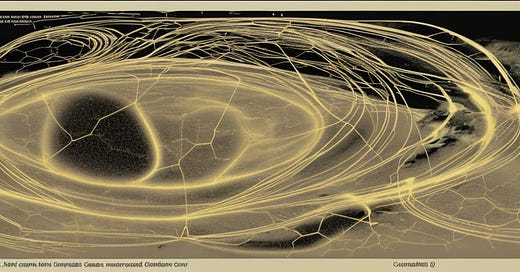[AI Statement: My older articles use imagery generated by the first-generation stable diffusion model. I am now committed to using only public domain images. No AI or LLM has been consulted on the research or writing of the below text, except sometimes for translations, and those have all been checked by a human with knowledge of the source language and English.]
[{Intro}, {A}, {B}, {C}, {D)i.}, {D)ii.}, {E)i.}, {E)ii. Conclusion}]
Fuels, and particularly liquid fuels both in their raw material and finished states, have become key money-commodities in use by the financial system today, famously attached to the dollar to make the combined Petrodollar the universal world currency. Marx essentially predicted that eventually currencies would become unmoored from their representational relationship with specific quantities of mineral value. He recognized that money is not required to be gold, or gold-equivalent. This implicit prophecy only came true well into the oil energy regime in the 2nd half of the 20th century. Already, when the dollar finally left gold, oil had become deeply intertwined with the very centers of finance globally. In fact, the American oil interests ran on financed debt from its earliest days, which is why Patillo Higgens owned none of the oil that was produced from “his” Spindletop well. Even in those earliest days, oil was owned by the banks even before it came out of the ground.
This is because the physical properties of oil predetermined its alignment with financial capital. The fact that oil, at least by the geologic understanding of the day, was heavily concentrated in remote and rare underground reservoirs that could be quite immense, meant that exploring for oil a very risky gamble that attracted a noticeably lumpen group of men who were comfortable living on the knife’s edge between abject poverty and striking it rich: Wildcatters. These men depended on finance capital to loan them the funds to buy a lease, often on nothing more than a hunch or a dream, and to finance the drilling. Most of the time–data aren’t reliably preserved–the only result was a very deep dry hole. Most of them found it more profitable to sell the prospect of oil drilling to investors and then keep the money. One archetypical such man was Dad Joiner, born Columbus Joiner, but known as Dad of the East Texas oil industry. Before he struck big, “Dad Joiner was virtually invisible, just another of the thousands of threadbare promoters, each with an idea, the promise of riches, and the gift of gab. For three years, beginning in 1927, while the industry’s leaders carried on their furious debate about shortage and glut and regulation, Joiner–the poorest of the poor boys–and his motley crew were drilling mid the dense pine trees of East Texas with rusted, third-hand equipment, constantly tormented by breakdowns and accidents, always short of even the barest cash.” (Yergin 246) “He had been very cavalier in his promotion, to put it generously. He had sold more “interests” than there were interests to sell. Some leases had been sold several times over, and in at least one lease eleven separate times.” The lawyers and the bankers owned the oil he discovered, from the first gurgle heard from the Daisy Bradford Well Number 3. He got nothing, and neither did his motley crew of drillers. This allowed HL Hunt to take over the whole enterprise on the cheap. As the capital flows centralized, Houston grew as a center of American finance, and oil was forever bound up with the industry of money itself. The truly big oilmen are bankers, and very few exploration companies turn a profit, even today when fracking has ended the risk of drilling a dry hole. You want to own the debt, not owe it.
During the age of the American empire–which we’re still in, but set to leave soon–the dominant currency was the petrodollar, which was guaranteed not only by the American government, but also by the Texan company, Aramco, which, along with the other oil majors, agreed to only sell oil around the world in dollars. Most of this story should be told within the actual petrohistorical narrative that comprises the bulk of this project. What we must keep an eye on is the fact that though oil sells labour, it is intimately tied to capital itself, to the point where it functions as capital and can replace currency itself. Therefore its own interests lie aligned with the Western ruling class.


